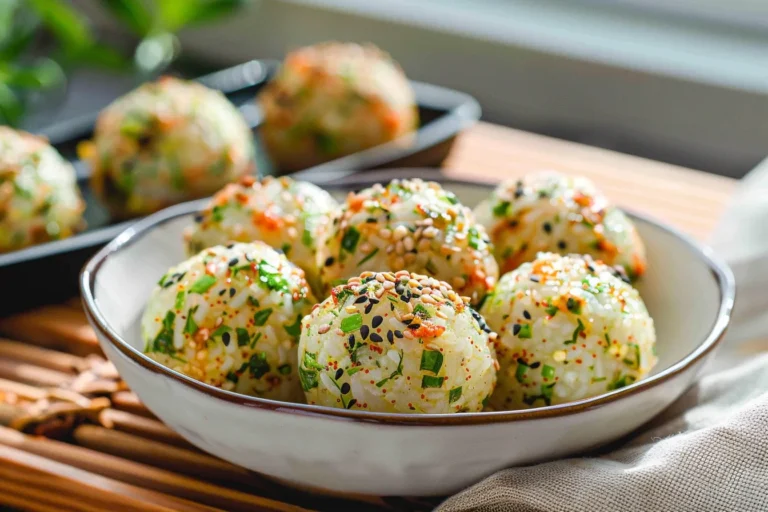Introduction
Jumeokbap, or “fist rice,” holds a special place in Korean cuisine as a cherished and traditional snack. This dish consists of seasoned rice combined with a variety of fillings, expertly shaped into compact, portable balls. Historically, jumeokbap traces its roots back to Korean farmers and travelers who favored it for its convenience and ease of transport. Over the years, it has evolved from a practical meal option into a beloved feature at social gatherings, including picnics and parties. Today, jumeokbap is celebrated not only for its convenience but also for encapsulating the rich, diverse flavors of Korean cuisine in every bite, making it a quintessential choice for a quick and satisfying meal.

Ingredients
Creating the perfect Jumeokbap starts with the right ingredients. Here’s what you’ll need:
- 2 cups of cooked short-grain rice – It’s essential for the rice to be sticky enough to hold the balls together.
- 1/2 cup of finely chopped carrots – Adds a slight sweetness and crunch.
- 1/2 cup of finely chopped spinach – A good source of iron and adds a vibrant green color.
- 1/4 cup of finely chopped pickled radish (optional) – Enhances the balls with its tangy flavor.
- 2 tablespoons of soy sauce – For that deep umami taste.
- 1 tablespoon of sesame oil – Brings a rich, aromatic flavor to the rice.
- 1 teaspoon of minced garlic – Adds a bit of spice and intensity.
- Salt to taste – Helps to balance and enhance the overall flavors.
- Sesame seeds for garnish – Provides a nutty flavor and decorative look.
- Seaweed strips for wrapping (optional) – Gives an authentic touch and savory flavor.

Directions
Preparing the Base
- Season the Rice: In a large bowl, thoroughly mix the cooked rice with soy sauce, sesame oil, and minced garlic. This initial step is crucial as it seasons the rice which forms the base of the balls.
- Incorporate the Vegetables: Add the chopped carrots, spinach, and optional pickled radish. Stir until these ingredients are evenly distributed throughout the rice.
Shaping and Finishing
- Form the Balls: With clean, slightly wet hands, take a portion of the rice mixture and press it firmly between your palms to form a ball. The size of each ball can be about the size of a golf ball, which is perfect for a single bite.
- Garnish and Wrap: Roll the rice balls in sesame seeds for an added texture and flavor boost. If you like, wrap each ball in a strip of seaweed for a traditional Korean touch.
- Serve: These rice balls are best enjoyed immediately. However, they can also be stored and packed for a convenient snack or meal on the go.
Customizations and Variations
Jumeokbap is highly customizable. Here are a few variations to spice up the basic recipe:
- Protein-Packed Jumeokbap: Add chopped cooked chicken, tuna, or tofu to the rice mixture for added protein.
- Vegan Jumeokbap: Use tamari instead of soy sauce and ensure all other ingredients are plant-based.
- Spicy Jumeokbap: Introduce a teaspoon of Korean chili paste (gochujang) to the mixture for those who favor a bit of heat.
- Nutty Jumeokbap: Mix in crushed peanuts or almonds for a crunchy texture.
Notes on Preparation
- Rice Consistency: The rice should be slightly warm when mixing to ensure it is sticky enough to form well-shaped balls.
- Handling: Keep your hands wet while forming the balls to prevent sticking and to achieve a smooth surface.
Nutritional Information
Each serving of Jumeokbap is not only tasty but also nutritious. The balls are low in calories, high in complex carbohydrates, and can be a good source of vitamins if made with a variety of vegetables. They contain about 180 calories per serving, making them a great option for a light meal or a filling snack.
Culinary Tips
- Enhance the Flavor: For an extra flavor kick, a little sesame seed oil or a few drops of rice vinegar can be mixed into the rice before adding other ingredients.
- Serving Suggestions: Jumeokbap pairs wonderfully with soy sauce for dipping, or a side of kimchi for a truly Korean dining experience.
FAQs
Q: How long can you keep Jumeokbap?
A: Jumeokbap can be stored in an airtight container in the refrigerator for up to two days. This makes them an excellent option for preparing meals in advance, ensuring you have a quick, tasty, and nutritious meal ready to go. To maintain the best quality, it’s recommended to consume them within this timeframe.
Q: Are there any other grains I can use to make Jumeokbap?
A: Absolutely! While traditional jumeokbap is typically made with short-grain rice, known for its sticky texture that holds the rice balls together, you can certainly experiment with other types of grains. Medium-grain rice, which is slightly less sticky than short-grain, can be used for a similar texture. For those looking to incorporate more nutrition into their meals, mixed grains such as brown rice, barley, or even quinoa can also be excellent alternatives, offering varied textures and enhanced nutritional benefits. Experimenting with different grains can bring a delightful twist to this classic dish.
Q: Can I add protein to my Jumeokbap?
A: Yes, incorporating proteins into jumeokbap is a great way to make the meal more filling and nutritious. Common protein additions include cooked and shredded chicken, canned tuna, or cooked and crumbled tofu. These can be mixed into the rice or used as fillings, providing both flavor and substance to the rice balls.
Q: What are some common fillings for Jumeokbap?
A: Jumeokbap fillings can vary widely, but popular choices include seasoned vegetables like spinach or carrot, kimchi, and a variety of seafood such as seasoned roe or cooked shrimp. For a savory touch, small pieces of fried egg or sautéed mushrooms are also favorites. These fillings can be combined in various ways to suit your taste preferences.
Q: Is Jumeokbap suitable for vegetarians or vegans?
A: Yes, jumeokbap can be easily adapted for vegetarian or vegan diets. You can opt for plant-based fillings such as sautéed vegetables, kimchi (ensure it’s vegan, as some kimchi is made with fish sauce), or tofu. Using plant-based ingredients not only adheres to vegetarian and vegan dietary requirements but also adds a fresh, healthy component to the meal
Conclusion
Korean Rice Balls are a delightful addition to any meal, offering versatility and nutrition packed into a compact, flavorful snack. This guide not only provides the basics of making traditional Jumeokbap but also encourages you to experiment with ingredients and flavors to create a dish that reflects your personal taste preferences. Enjoy the simplicity and the cultural richness of this beloved Korean dish in your own kitchen!
This detailed exploration into making Korean Rice Balls (Jumeokbap) aims to provide you with all the knowledge needed to master this dish, from the fundamental techniques to more innovative adaptations. With this guide, you are well on your way to impressing family and friends with your culinary skills while enjoying a taste of Korean tradition.

Mastering the Art of Korean Rice Balls (Jumeokbap): A Comprehensive Guide
- Author: Sara
- Prep Time: 20 mins
- Cook Time: 10 mins
- Total Time: 30 minutes
- Cuisine: Korean
Description
Jumeokbap, which literally translates to “fist rice,” is a beloved snack in Korea, made from seasoned rice and various fillings, shaped into compact balls. Its origins can be traced back to being a convenient meal for farmers and travelers because they were easy to transport and consume on the go. Today, they are a popular choice for picnics, lunchboxes, and even as party food, providing a delicious way to enjoy the essence of Korean flavors in a single bite.
Ingredients
- 2 cups of cooked short-grain rice – It’s essential for the rice to be sticky enough to hold the balls together.
- 1/2 cup of finely chopped carrots – Adds a slight sweetness and crunch.
- 1/2 cup of finely chopped spinach – A good source of iron and adds a vibrant green color.
- 1/4 cup of finely chopped pickled radish (optional) – Enhances the balls with its tangy flavor.
- 2 tablespoons of soy sauce – For that deep umami taste.
- 1 tablespoon of sesame oil – Brings a rich, aromatic flavor to the rice.
- 1 teaspoon of minced garlic – Adds a bit of spice and intensity.
- Salt to taste – Helps to balance and enhance the overall flavors.
- Sesame seeds for garnish – Provides a nutty flavor and decorative look.
- Seaweed strips for wrapping (optional) – Gives an authentic touch and savory flavor.
Instructions
- Season the Rice: In a large bowl, thoroughly mix the cooked rice with soy sauce, sesame oil, and minced garlic. This initial step is crucial as it seasons the rice which forms the base of the balls.
- Incorporate the Vegetables: Add the chopped carrots, spinach, and optional pickled radish. Stir until these ingredients are evenly distributed throughout the rice.
Shaping and Finishing
- Form the Balls: With clean, slightly wet hands, take a portion of the rice mixture and press it firmly between your palms to form a ball. The size of each ball can be about the size of a golf ball, which is perfect for a single bite.
- Garnish and Wrap: Roll the rice balls in sesame seeds for an added texture and flavor boost. If you like, wrap each ball in a strip of seaweed for a traditional Korean touch.
- Serve: These rice balls are best enjoyed immediately. However, they can also be stored and packed for a convenient snack or meal on the go.
Notes
- Rice Consistency: The rice should be slightly warm when mixing to ensure it is sticky enough to form well-shaped balls.
- Handling: Keep your hands wet while forming the balls to prevent sticking and to achieve a smooth surface.

